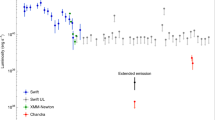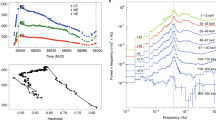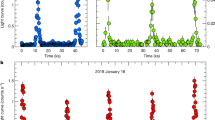Abstract
A 3-min outburst of very-high energy (VHE) quanta, E > 1012 eV, was recently detected from the X-ray pulsar Hercules X-1 (ref. 1). The outburst occurred at a time during the 35-day X-ray modulation that is associated with X-ray turn-on. Temporal analysis of the outburst showed the same 1.24-s modulation that is observed at X-ray energies. Subsequent monitoring of the system at ultra-high energies (UHE) by the Fly's Eye2 yielded evidence for a 40-min outburst of quanta with energies E>1×l014TeV. This UHE outburst also exhibited a 1.24-s modulation. Here we assume the quanta to be γ-rays and show how the interaction of these UHE particles with a precessing accretion disk can explain the observed γ-ray ‘light’ curve. We also discuss the possibility that the emitting UHE particles are accelerated by shocks in an accretion flow as well as the constraints that can be placed on the acceleration mechanism.
This is a preview of subscription content, access via your institution
Access options
Subscribe to this journal
Receive 51 print issues and online access
$199.00 per year
only $3.90 per issue
Buy this article
- Purchase on Springer Link
- Instant access to full article PDF
Prices may be subject to local taxes which are calculated during checkout
Similar content being viewed by others
References
Dowthwaite, J. et al. Nature 309, 691–693 (1984).
Baltrusaitis, R. M. et al. Preprint, Univ. Utah (1985).
Giacconi, R. et al. Astrophys. J. 184, 227–236 (1973).
Jones, C. & Forman, W. Astrophys. J. Lett. 209, L131–L135 (1976).
Petterson, J. A. Astrophys. J. Lett. 201, L61–L64 (1975).
Petterson, J. A. Astrophys. J. 218, 783–791 (1977).
Boynton, P., Crosa, L. & Deeter, J. Astrophys. J. 237, 169–174 (1980).
Eichler, D. Nature 275, 725–726 (1978).
Vestrand, W. T. & Eichler, D. Proc. of the Workshop on Particle Acceleration in Astrophysics, La Jolla (eds Arons, M. & McKee) 285–288 (1979).
Eichler, D. & Vostrand, W. T., Proc. of the 16th International Cosmic Ray Conf., Kyoto, 1, 147–149 (1979).
Vestrand, W. T. & Eichler, D. Astrophys. J. 261, 251–258 (1982).
Protheroe, R. J. & Clay, R. W. Nature 315, 205–207 (1985).
Parmar, A. N. et al. Nature 313, 119–121 (1985).
Delgado, A. J., Schmidt, H. U. & Thomas, H. C. Astr. Astrophys. Lett. 127, L15–L16 (1983).
Chanmugham, G. & Brecher, K. Nature 313, 767–768 (1985).
Eichler, D. Astrophys. J. 229, 419 (1979).
Cowsik, R. & Lee, M. A. Proc. R. Soc. A383, 409–423 (1982).
Eichler, D. Astrophys. J. 244, 711–716 (1981).
Samorski, M. & Stamm, W. Astrophys. J. 268, L17–L21 (1985).
Author information
Authors and Affiliations
Rights and permissions
About this article
Cite this article
Eichler, D., Vestrand, W. Implications of ultra-high-energy emission from Hercules X-1. Nature 318, 345–347 (1985). https://doi.org/10.1038/318345a0
Received:
Accepted:
Issue Date:
DOI: https://doi.org/10.1038/318345a0
This article is cited by
-
TeV emission from close binaries
Space Science Reviews (1995)
-
The plasma physics of shock acceleration
Space Science Reviews (1991)
-
Surprises in the skies
Nature (1987)
-
Pulsed TeV gamma-rays from Vela X-1
Nature (1987)
-
Companion-star beam steering of high-energy particles from Hercules X-1
Nature (1986)
Comments
By submitting a comment you agree to abide by our Terms and Community Guidelines. If you find something abusive or that does not comply with our terms or guidelines please flag it as inappropriate.



